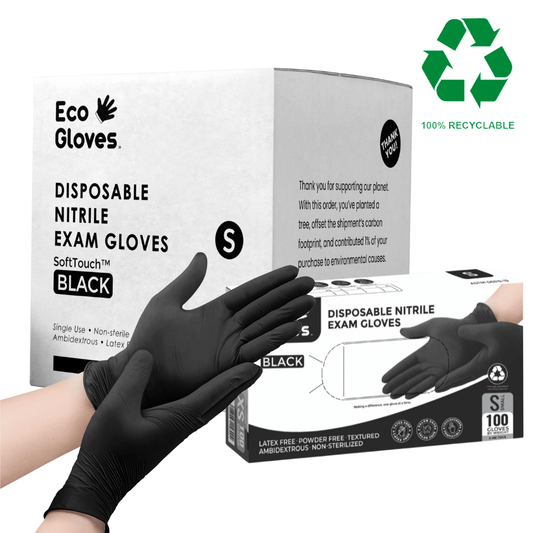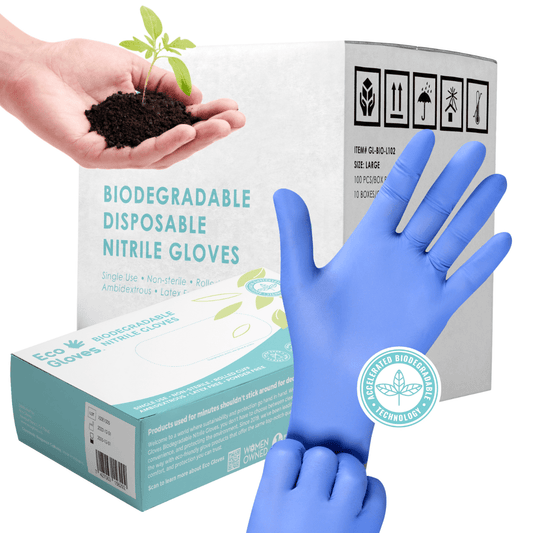Wearing Gloves for Food Safety
Eco Gloves
Wearing gloves can keep food safe by preventing cross-contamination and ensuring proper hygiene during food preparation and handling.
Unfortunately, gloves alone cannot do it all. Use these key points to remind your food workers that good hand hygiene along with proper use of gloves are an important step in safe food handling.
Topics Covered
- Who is Considered a Food Handler?
- Why wear gloves for food handling?
- How wearing gloves can keep food safe
- How often should food handlers change gloves?
- Key Takeaways: Best Gloves for Wearing Gloves for Food Safety
-
Frequently Asked Questions About Wearing Gloves for Food Safety
Who is Considered a Food Handler?
First of all, to understand who should be wearing gloves we should first explore what it means to be a food handler.
A food handler is anyone who comes in direct contact with food during any phase in the supply chain until it reaches the customer. This could be anyone involved in the supplying, preparation, manufacturing, processing, packaging, storing, transporting, distribution, sale or service of food.
Simply put, a food handler is any person who handles food or comes in contact with food in his or her normal work routine on a daily basis. Below is are some types of jobs and settings where workers come in contact with food:
- Chefs and Cooks - oversee the daily food preparation at restaurants and other places where food is served. They direct kitchen staff and handle any food-related concerns.
- Fast Food Workers - take and fill customers' orders for food and drinks. Sometimes they can be in charge of assembling some items, such as sandwiches and salads.
- Food Preparation Workers - handle a myriad of food prep work, including preparing fruit and vegetables for cooking, cutting meats, poultry and seafood and preparing them for cooking, mixing ingredients, and much more.
- Butchers and Meat Cutters - weigh, cut, trim, and package meat, poultry or seafoods for retail sale.
- Food Cooking Machine Operators and Tenders - operate or tend cooking equipment, such as steam cooking vats, deep fry cookers, pressure cookers, kettles, and boilers, to prepare food products.
- Meat Packers - prepare large portions of raw meat. Their work may include specialized slaughtering tasks, cutting standard or premium cuts of meat for marketing, making sausage, or wrapping meats.
- Graders and Sorters - sort and classify unprocessed food and other agricultural products.
- Dining Room, Cafeteria Attendants and Bartender Helpers - serve and maintain food service bars.
-
Testers and Samplers - inspect and weight ingredients and food.
Food Handlers at Every Point in the Supply Chain

As you can see, many industries employ food handlers, from food manufacturing to schools, hotels and food service industry itself. Across these industries food handlers are expected to meet food hygiene requirements and wear proper hand protection to ensure the hygienic preparation of everything they touch.
Why wear gloves for food handling?
Aside from protecting the users hands, gloves have become a necessary tool in food handling to help prevent the transmission of germs and pathogens that can be spread through bare hand contact with foods.
In fact, the National Advisory Committee on Microbiological Criteria for Foods concluded over 15 years ago that bare hand contact with food contributes greatly to the transmission of foodborne illnesses. Food handlers can very easily shed viral pathogens if they are infected, and they can shed these pathogens even before they realize they are sick. Most of these pathogens have a low infective dose, meaning that people don’t have to ingest many of them before they start to get sick.
Since the FDA concluded that handwashing alone is not sufficient to prevent transmission of pathogens, gloves have become the industry standard to provide another barrier between potentially dangerous pathogens and the food the worker is preparing. This is especially important when handling raw foods or preparing foods that will not go through a cooking step before it reaches the customer.
Practicing good hand hygiene while practicing proper glove use are essential to protecting users and the customers.

How wearing gloves can keep food safe
While wearing gloves can help reduce the potential spread of foodborne illnesses, proper use of them is key in ensuring that the user and the food being handled remains safe.
If those handling food don’t wash their hands before putting on gloves or don’t put gloves on properly, the gloves could be as easily contaminated with dangerous pathogens and transfer on to the food. That is why it is always important that workers must wash their hands thoroughly before putting on a new pair of gloves, whenever they put on a new pair.
Another thing to keep in mind is that disposable gloves should not be re-worn or washed for reuse, especially after they’ve been in use with handling different types of foods and meats as this can cause possible cross contamination.
How often should food handlers change gloves?
Since gloves can become easily contaminated, they must be changed often.
As they are named, disposable gloves are meant to be disposed of after use after one task. They should also be discarded if damaged or if the user is interrupted between or during tasks. If the user is performing the same task, the gloves must be changed every 10 to 20 minutes because that’s the amount of time it takes for pathogens to multiply.
Anytime the gloves become contaminated, they must be changed. This includes if the user simply touches a part of their exposed skin, or if they perform a task such as taking out the garbage.
Disposable gloves are a great tool to help protect users and the customers from foodborne illnesses as long as they are used correctly. For a guide on how to properly wear gloves, check out the diagram below.

Key Takeaways: Wearing Gloves for Food Safety
-
Critical for Hygiene: Gloves provide a barrier against germs and pathogens, reducing the risk of foodborne illness.
-
Not a Substitute for Handwashing: Proper handwashing before wearing gloves is essential to prevent contamination.
-
Industry-Wide Application: From chefs and butchers to food packers and graders, food handlers across the supply chain should wear gloves.
-
Proper Use Prevents Risk: Gloves must be changed frequently—every 10–20 minutes or after contamination—to remain effective.
-
Single-Use Only: Disposable gloves should never be reused or washed for another task.
-
FDA-Recognized Benefit: Gloves, used with good hygiene practices, help meet food safety regulations and protect public health.
👉 Wearing gloves correctly—and combining them with proper hygiene—keeps food safer, customers healthier, and businesses in compliance.
Frequently Asked Questions About Wearing Gloves for Food Safety
-
Who is considered a food handler?
Anyone who touches food during preparation, processing, packaging, storage, transport, or service—from chefs to graders and servers.
-
Why are gloves important in food handling?
They help prevent the spread of germs and pathogens that can cause foodborne illnesses, especially when handling ready-to-eat foods.
-
Do gloves replace the need for handwashing?
No. Hands must be washed thoroughly before putting on gloves to prevent contaminating the gloves themselves.
-
How often should food handlers change gloves?
At least every 10–20 minutes, between tasks, when gloves are damaged, or any time contamination occurs.
-
Can disposable gloves be reused?
No. They are designed for single use and should be discarded after each task to avoid cross-contamination.
-
What happens if gloves are not used correctly?
Improper use can transfer dangerous pathogens to food, negating their protective purpose.















